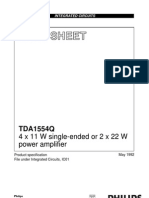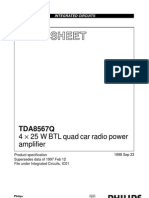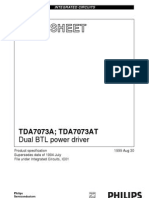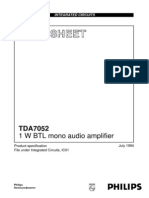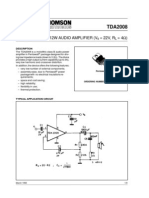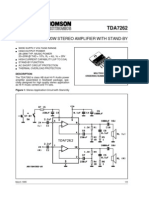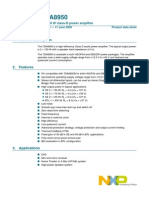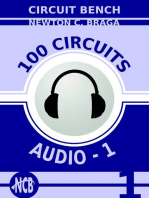Tda 1552 Q
Tda 1552 Q
Uploaded by
Anderson PotrikusCopyright:
Available Formats
Tda 1552 Q
Tda 1552 Q
Uploaded by
Anderson PotrikusCopyright
Available Formats
Share this document
Did you find this document useful?
Is this content inappropriate?
Copyright:
Available Formats
Tda 1552 Q
Tda 1552 Q
Uploaded by
Anderson PotrikusCopyright:
Available Formats
INTEGRATED CIRCUITS
DATA SHEET
TDA1552Q 2 x 22 W BTL stereo car radio power amplifier
Product specication File under Integrated Circuits, IC01 July 1994
Philips Semiconductors
Product specication
2 x 22 W BTL stereo car radio power amplier
GENERAL DESCRIPTION
TDA1552Q
The TDA1552Q is an integrated class-B output amplifier in a 13-lead single-in-line (SIL) plastic power package. The circuit contains 2 x 22 W amplifiers in Bridge Tied Load (BTL) configuration. The device is primarily developed for car radio applications. Features Requires very few external components High output power Low offset voltage at outputs Fixed gain Good ripple rejection Mute/stand-by switch Load dump protection AC and DC short-circuit-safe to ground and VP QUICK REFERENCE DATA PARAMETER Supply voltage range operating non-operating load dump protected Repetitive peak output current Total quiescent current Stand-by current Switch-on current Input impedance Junction temperature Stereo application Output power Supply voltage ripple rejection DC output offset voltage Channel separation Channel unbalance RS = 0 f = 100 Hz to 10 kHz RR |VO| |Gv| 48 40 150 1 dB mV dB dB RL = 4 ; THD = 10% Po 20 22 W IORM Itot Isb Isw |ZI| Tj 50 80 0.1 60 4 160 100 60 75 150 A mA A A k C VP VP VP 6.0 14.4 18.0 30 45 V V V CONDITIONS SYMBOL MIN. TYP. MAX. UNIT Thermally protected Reverse polarity safe Capability to handle high energy on outputs (VP = 0 V) Protected against electrostatic discharge No switch-on/switch-off plop Low thermal resistance Flexible leads.
PACKAGE OUTLINE 13-lead SIL-bent-to-DIL; plastic power (SOT141R); SOT 141-6; 1996 July 23.
July 1994
Philips Semiconductors
Product specication
2 x 22 W BTL stereo car radio power amplier
TDA1552Q
handbook, full pagewidth
V P1 3 input 1 1 mute switch Cm
V P2 10
VA 2 k 18 k power stage mute switch
output 1A
Cm
VA 60 k 2 k 18 k VP power stage
output 1B
11 stand-by switch VA 15 k x1 15 k V ref 13 mute switch Cm mute switch stand-by reference voltage 12
mute/stand-by not connected
TDA1552Q
input 2
VA 2 k 18 k power stage mute switch
output 2B
Cm
VA 60 k Vref 2 k 18 k power stage 5 GND1 ground (signal) power ground (substrate) 8 GND2
output 2A
MLB952
Fig.1 Block diagram.
July 1994
Philips Semiconductors
Product specication
2 x 22 W BTL stereo car radio power amplier
PINNING 1 2 3 4 5 6 7 IP1 GND VP1 OUT1A GND1 OUT1B OUT2A input 1 ground (signal) positive supply voltage 1 output 1A power ground 1 (substrate) output 1B output 2A 8 9 10 11 12 13 GND2 OUT2B VP2 M/SS n.c. IP2
TDA1552Q
power ground 2 (substrate) output 2B positive supply voltage 2 mute/stand-by switch not connected input 2
FUNCTIONAL DESCRIPTION The TDA1552Q contains two identical amplifiers with differential input stages and can be used for bridge applications. The gain of each amplifier is fixed at 26 dB. A special feature of this device is: Mute/stand-by switch low stand-by current (< 100 A) low mute/stand-by switching current (low cost supply switch) mute facility. RATINGS Limiting values in accordance with the Absolute Maximum System (IEC 134) PARAMETER Supply voltage operating non-operating load dump protected Non-repetitive peak output current Repetitive peak output current Storage temperature range Junction temperature AC and DC short-circuit-safe voltage Energy handling capability at outputs Reverse polarity Total power dissipation see Fig.2 VP = 0 V VPR Ptot during 50 ms; tr 2.5 ms VP IOSM IORM Tstg Tj VPSC 55 45 6 4 +150 150 18 200 6 60 V A A C C V mJ V W VP VP 18 30 V V CONDITIONS SYMBOL MIN. MAX. UNIT
July 1994
Philips Semiconductors
Product specication
2 x 22 W BTL stereo car radio power amplier
TDA1552Q
Fig.2 Power derating curve.
July 1994
Philips Semiconductors
Product specication
2 x 22 W BTL stereo car radio power amplier
DC CHARACTERISTICS VP = 14.4 V; Tamb = 25 C; measurements taken using Fig.3; unless otherwise specied PARAMETER Supply Supply voltage range Total quiescent current DC output voltage DC output offset voltage Mute/stand-by switch Switch-on voltage level Mute condition Output signal in mute position DC output offset voltage (between pins 4 to 6 and 7 to 9) Stand-by condition DC current in stand-by condition Switch-on current Supply current short-circuit to GND note 3 IP 5.5 VII < 0.5 V 0.5 V VII < 2 V |VO| Vsb Isb Isb Isw 0 25 VI = 1 V (max); f = 1 kHz VO VON Vmute 8.5 3.3 note 2 note 1 VP Itot VO |VO| 6.0 14.4 80 6.9 CONDITIONS SYMBOL MIN. TYP.
TDA1552Q
MAX.
UNIT
18.0 160 150 6.4
V mA V mV
V V
2 150 2 100 500 60
mV mV V A A A
mA
July 1994
Philips Semiconductors
Product specication
2 x 22 W BTL stereo car radio power amplier
TDA1552Q
AC CHARACTERISTICS VP = 14.4 V; RL = 4 ; f = 1 kHz; Tamb = 25 C; measurements taken using Fig.3; unless otherwise specied PARAMETER Output power Output power at VP = 13.2 V Total harmonic distortion Power bandwidth CONDITIONS THD = 0.5% THD = 10% THD = 0.5% THD = 10% Po = 1 W THD = 0.5% Po = 1 dB w.r.t. 15 W Low frequency roll-off High frequency roll-off Closed loop voltage gain Supply voltage ripple rejection ON mute stand-by Input impedance Noise output voltage (RMS value) ON ON mute Channel separation Channel unbalance Notes to the characteristics 1. The circuit is DC adjusted at VP = 6 V to 18 V and AC operating at VP = 8.5 V to 18 V. 2. At 18 V < VP < 30 V the DC output voltage VP/2. 3. Conditions: a) V11 = 0 V b) short-circuit to GND c) switch V11 to MUTE or ON condition (rise time 10 s). 4. Frequency response externally fixed. 5. Ripple rejection measured at the output with a source impedance of 0 (maximum ripple amplitude of 2 V). 6. Frequency f = 100 Hz. 7. Frequency between 1 kHz and 10 kHz. 8. Noise voltage measured in a bandwidth of 20 Hz to 20 kHz. 9. Noise output voltage independent of RS (VI = 0 V). July 1994 7 RS = 0 ; note 8 notes 8, 9 Vno(rms) Vno(rms) |Gv| 40 70 100 60 120 1 V V A dB dB RS = 10 k; note 8 Vno(rms) notes 5, 6 notes 5, 7 notes 5, 6, 7 notes 5, 6, 7 note 4 1 dB 1 dB fL fH Gv RR RR RR RR |Zi| 20 25 42 48 48 80 50 25 26 60 27 75 Hz kHz dB dB dB dB dB k Bw 20 to 15000 Hz SYMBOL Po Po Po Po THD MIN. 15 20 TYP. 17 22 12 17 0.1 MAX. UNIT W W W W %
Philips Semiconductors
Product specication
2 x 22 W BTL stereo car radio power amplier
APPLICATION INFORMATION
TDA1552Q
handbook, full pagewidth
mute/stand-by switch not connected
VP 100 nF 2200 F
14.4 V
12 220 nF input 1
11
10
1 4
60 k 6
R =4 L
ground (signal)
TDA1552Q
reference voltage
220 nF input 2
13 9
60 k 7
R =4 L
MLB951
power ground (substrate)
Fig.3 Application circuit diagram.
July 1994
Philips Semiconductors
Product specication
2 x 22 W BTL stereo car radio power amplier
PACKAGE OUTLINE DBS13P: plastic DIL-bent-SIL power package; 13 leads (lead length 12 mm)
TDA1552Q
SOT141-6
non-concave x D Dh
Eh
view B: mounting base side
A2
B j E A
L3
Q c
1 Z e e1 bp w M
13 m e2 v M
5 scale
10 mm
DIMENSIONS (mm are the original dimensions) UNIT mm A 17.0 15.5 A2 4.6 4.2 bp 0.75 0.60 c 0.48 0.38 D (1) 24.0 23.6 d 20.0 19.6 Dh 10 E (1) 12.2 11.8 e 3.4 e1 1.7 e2 5.08 Eh 6 j 3.4 3.1 L 12.4 11.0 L3 2.4 1.6 m 4.3 Q 2.1 1.8 v 0.8 w 0.25 x 0.03 Z (1) 2.00 1.45
Note 1. Plastic or metal protrusions of 0.25 mm maximum per side are not included. OUTLINE VERSION SOT141-6 REFERENCES IEC JEDEC EIAJ EUROPEAN PROJECTION
ISSUE DATE 92-11-17 95-03-11
July 1994
Philips Semiconductors
Product specication
2 x 22 W BTL stereo car radio power amplier
SOLDERING Introduction There is no soldering method that is ideal for all IC packages. Wave soldering is often preferred when through-hole and surface mounted components are mixed on one printed-circuit board. However, wave soldering is not always suitable for surface mounted ICs, or for printed-circuits with high population densities. In these situations reflow soldering is often used. This text gives a very brief insight to a complex technology. A more in-depth account of soldering ICs can be found in our IC Package Databook (order code 9398 652 90011). Soldering by dipping or by wave The maximum permissible temperature of the solder is 260 C; solder at this temperature must not be in contact with the joint for more than 5 seconds. The total contact time of successive solder waves must not exceed 5 seconds. DEFINITIONS Data sheet status Objective specication Preliminary specication Product specication Limiting values
TDA1552Q
The device may be mounted up to the seating plane, but the temperature of the plastic body must not exceed the specified maximum storage temperature (Tstg max). If the printed-circuit board has been pre-heated, forced cooling may be necessary immediately after soldering to keep the temperature within the permissible limit. Repairing soldered joints Apply a low voltage soldering iron (less than 24 V) to the lead(s) of the package, below the seating plane or not more than 2 mm above it. If the temperature of the soldering iron bit is less than 300 C it may remain in contact for up to 10 seconds. If the bit temperature is between 300 and 400 C, contact may be up to 5 seconds.
This data sheet contains target or goal specications for product development. This data sheet contains preliminary data; supplementary data may be published later. This data sheet contains nal product specications.
Limiting values given are in accordance with the Absolute Maximum Rating System (IEC 134). Stress above one or more of the limiting values may cause permanent damage to the device. These are stress ratings only and operation of the device at these or at any other conditions above those given in the Characteristics sections of the specication is not implied. Exposure to limiting values for extended periods may affect device reliability. Application information Where application information is given, it is advisory and does not form part of the specication. LIFE SUPPORT APPLICATIONS These products are not designed for use in life support appliances, devices, or systems where malfunction of these products can reasonably be expected to result in personal injury. Philips customers using or selling these products for use in such applications do so at their own risk and agree to fully indemnify Philips for any damages resulting from such improper use or sale.
July 1994
10
You might also like
- Four Piece Suite For Two Pianos 1 PDFDocument36 pagesFour Piece Suite For Two Pianos 1 PDFMikyung Joo75% (4)
- "Across The Universe" AnalysisDocument6 pages"Across The Universe" AnalysisdudderdogNo ratings yet
- TDA1554Q 44W Audio AmplifierDocument11 pagesTDA1554Q 44W Audio Amplifiersava7698No ratings yet
- TDA1557QDocument11 pagesTDA1557QLuiz FernandoNo ratings yet
- Data Sheet: TDA1510AQDocument12 pagesData Sheet: TDA1510AQGerardo PonceNo ratings yet
- Tda 1517Document11 pagesTda 1517minhchatnguyenNo ratings yet
- Data Sheet: 2 X 6 W Stereo Car Radio Power AmplifierDocument10 pagesData Sheet: 2 X 6 W Stereo Car Radio Power Amplifierazzeddine_a7601No ratings yet
- Tda 1517Document14 pagesTda 1517Cris VMNo ratings yet
- TDA1552QDocument11 pagesTDA1552QMaja i Aleksandar JovanovićNo ratings yet
- Tda 2613 QDocument11 pagesTda 2613 Qpaulmx13No ratings yet
- TDA1555QDocument11 pagesTDA1555QНикифор СтанојоскиNo ratings yet
- T Tda8563qDocument16 pagesT Tda8563qdanionescu2022No ratings yet
- Data Sheet: TDA1558QDocument11 pagesData Sheet: TDA1558QMarco Tulio Da SilvaNo ratings yet
- Data Sheet 4Document16 pagesData Sheet 4conti51No ratings yet
- TDA8560QDocument17 pagesTDA8560QJo BuNo ratings yet
- Data Sheet: 2 To 6 W Audio Power AmplifierDocument14 pagesData Sheet: 2 To 6 W Audio Power AmplifierSavio Alencar MacielNo ratings yet
- TDA7072 DatasheetDocument11 pagesTDA7072 Datasheetsergio_741No ratings yet
- Data Sheet: TDA8567QDocument20 pagesData Sheet: TDA8567QlthzufNo ratings yet
- TDA 1519cDocument21 pagesTDA 1519cCris VMNo ratings yet
- Tda8920 2x50w Rms Class D AmplifierDocument16 pagesTda8920 2x50w Rms Class D AmplifierMarcisio Souza0% (1)
- TDA8561QDocument25 pagesTDA8561QKarlitos Belt GarNo ratings yet
- TDA7073A DatasheetDocument17 pagesTDA7073A Datasheetsergio_741No ratings yet
- Datasheet PDFDocument11 pagesDatasheet PDFLOLONo ratings yet
- Tda 7052Document12 pagesTda 7052Mateus Soares Da SilvaNo ratings yet
- Tda 8566Document21 pagesTda 8566Rajkumar LodhNo ratings yet
- TDA1557QDocument10 pagesTDA1557QDaniel GureanuNo ratings yet
- Data Sheet: 1 W BTL Mono Audio AmplifierDocument9 pagesData Sheet: 1 W BTL Mono Audio AmplifierJuan Cruz PalmaNo ratings yet
- Tda 1564Document30 pagesTda 1564sirtetaNo ratings yet
- Tda2614 CNV 2Document11 pagesTda2614 CNV 2octalmNo ratings yet
- Data Sheet: TDA1554QDocument11 pagesData Sheet: TDA1554QSphinx DinopolNo ratings yet
- Tda 7052Document8 pagesTda 7052kunambersahajaNo ratings yet
- Tea2025b, D ST PDFDocument10 pagesTea2025b, D ST PDFblueword66No ratings yet
- Tda 7053Document13 pagesTda 7053Fer TgNo ratings yet
- Data Sheet: TDA2653ADocument12 pagesData Sheet: TDA2653Ad_richard_dNo ratings yet
- Data Sheet: 1 To 4 W Audio Power AmplifierDocument13 pagesData Sheet: 1 To 4 W Audio Power AmplifierThestrings91No ratings yet
- TDA8941P: 1. General DescriptionDocument21 pagesTDA8941P: 1. General DescriptionJosé Nicolás Auciello INo ratings yet
- Tda 7379 Data SheetDocument7 pagesTda 7379 Data SheetJCMNo ratings yet
- Tda 7384Document10 pagesTda 7384totovasiNo ratings yet
- TDA 6106qDocument12 pagesTDA 6106qqwertyuiNo ratings yet
- 60 W Hi-Fi Dual Audio Driver: DescriptionDocument12 pages60 W Hi-Fi Dual Audio Driver: DescriptionLenin BabuNo ratings yet
- Data Sheet: TDA1521 TDA1521QDocument15 pagesData Sheet: TDA1521 TDA1521QLevente BitaiNo ratings yet
- Data Sheet: Low Voltage Mono/stereo Power AmplifierDocument9 pagesData Sheet: Low Voltage Mono/stereo Power AmplifiergusguicorNo ratings yet
- Tda 1013Document11 pagesTda 1013Marin MarinescuNo ratings yet
- 3 Video Ampop - Tda6107qDocument16 pages3 Video Ampop - Tda6107qAnderson LuizNo ratings yet
- Tda 7250Document11 pagesTda 7250tica007No ratings yet
- TDA2008Document10 pagesTDA2008miusayNo ratings yet
- TDA1514ADocument10 pagesTDA1514AMuammar RiskiNo ratings yet
- TDA8920C: 1. General DescriptionDocument40 pagesTDA8920C: 1. General DescriptionDaniel QuishpeNo ratings yet
- Data Sheet: TDA6106QDocument13 pagesData Sheet: TDA6106Qban4444No ratings yet
- TDA7262Document9 pagesTDA7262Nelson PereiraNo ratings yet
- Tda8950 PDFDocument39 pagesTda8950 PDFElcura EdgarNo ratings yet
- Reference Guide To Useful Electronic Circuits And Circuit Design Techniques - Part 2From EverandReference Guide To Useful Electronic Circuits And Circuit Design Techniques - Part 2No ratings yet
- Reference Guide To Useful Electronic Circuits And Circuit Design Techniques - Part 1From EverandReference Guide To Useful Electronic Circuits And Circuit Design Techniques - Part 1Rating: 2.5 out of 5 stars2.5/5 (3)
- Analog Dialogue, Volume 48, Number 1: Analog Dialogue, #13From EverandAnalog Dialogue, Volume 48, Number 1: Analog Dialogue, #13Rating: 4 out of 5 stars4/5 (1)
- A Guide to Vintage Audio Equipment for the Hobbyist and AudiophileFrom EverandA Guide to Vintage Audio Equipment for the Hobbyist and AudiophileNo ratings yet
- LTE Field Testing RCR Feature ReportDocument24 pagesLTE Field Testing RCR Feature ReportDaniel RoureNo ratings yet
- Z-Match Single Coil ATUDocument4 pagesZ-Match Single Coil ATUJohn Howard GreenNo ratings yet
- Nyan Cat Advanced Piano Sheet MusicDocument6 pagesNyan Cat Advanced Piano Sheet Musiczazoue100% (1)
- Celce-Murcia Et Al. (2011) P. 208-212Document5 pagesCelce-Murcia Et Al. (2011) P. 208-212Apolinária GomesNo ratings yet
- WikiLeaks Podesta Email Leaks Archive Oct. 23, 2016Document50 pagesWikiLeaks Podesta Email Leaks Archive Oct. 23, 2016Joe Smith100% (1)
- Mbci PDFDocument8 pagesMbci PDFratheeshkumardNo ratings yet
- Dokumen UlanganDocument3 pagesDokumen UlanganNUR AZMI KHAIRANINo ratings yet
- Unit - 3: Microwave Diodes - Lecture 4 Impatt DiodeDocument3 pagesUnit - 3: Microwave Diodes - Lecture 4 Impatt DiodesuryaNo ratings yet
- Two Steps From Hell Virtuosic Piano Medley PDFDocument8 pagesTwo Steps From Hell Virtuosic Piano Medley PDFstudiok5No ratings yet
- Production Weekly - Issue 1110 - Thursday, September 13, 2018 / 194 Listings - 39 PagesDocument1 pageProduction Weekly - Issue 1110 - Thursday, September 13, 2018 / 194 Listings - 39 PagesProduction WeeklyNo ratings yet
- Concert Report Reflection Assignment Pt. 2Document3 pagesConcert Report Reflection Assignment Pt. 2Frankie NevinNo ratings yet
- Teachers Day 2024 CelebrationDocument5 pagesTeachers Day 2024 Celebrationlilharesurendra1No ratings yet
- Grade 9 MusicDocument18 pagesGrade 9 MusicJennifer AmugodNo ratings yet
- MRF0415 deDocument184 pagesMRF0415 dePetros TsenesNo ratings yet
- salinan-RRU-3510F8, P48N48T2R2Y03Document1 pagesalinan-RRU-3510F8, P48N48T2R2Y03feri kiswantoNo ratings yet
- Lisa - LalisaDocument3 pagesLisa - LalisaSyarani RosliNo ratings yet
- Samsung MAX-B550 User ManualDocument32 pagesSamsung MAX-B550 User ManualMauricio CorenoNo ratings yet
- New Blood - Youngblood Brass Band-1Document47 pagesNew Blood - Youngblood Brass Band-1LuísNo ratings yet
- Cultural TourismDocument10 pagesCultural TourismRAJENDRA BALOTIYANo ratings yet
- FDEME3L Notes For AssignmentDocument25 pagesFDEME3L Notes For Assignmentmmeiring123477% (13)
- Gun Lobby Fires Shot For Free Speech - Elementary PDFDocument5 pagesGun Lobby Fires Shot For Free Speech - Elementary PDFhahahapsuNo ratings yet
- Subcultures - BriefDocument32 pagesSubcultures - BriefhappysinhaNo ratings yet
- FM 44-2 Light Antiaircraft Artillery (Automatic Weapons) 1956Document206 pagesFM 44-2 Light Antiaircraft Artillery (Automatic Weapons) 1956dieudecafe100% (1)
- Final Exam MediaDocument3 pagesFinal Exam MediaSantos JewelNo ratings yet
- q3 - 1st Summative Test Music 9Document2 pagesq3 - 1st Summative Test Music 9jasmin diazNo ratings yet
- The Baroque SonataDocument3 pagesThe Baroque SonataYaminiTeresaPrabhuBarrettoNo ratings yet
- Historical Notes On The TinwhistleDocument2 pagesHistorical Notes On The Tinwhistletoo_many_liesNo ratings yet
- MufaruDocument10 pagesMufaruRegor AguinaldoNo ratings yet


